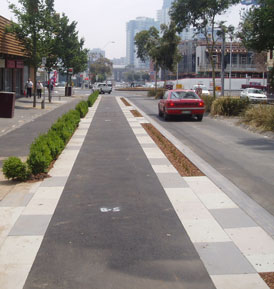Here's a little factoid that you might want to stow away—maybe it'll come up as a trivia quiz question someday: where was Melbourne's first 'Copenhagen' style bike lane?
Surely the answer is Swanston St? I mean, we've been hearing about the lane installation there for well over a year now. And Bicycle Victoria even says on its web site: First Copenhagen style bike lanes in Australia
.
Well, that should probably read First Copenhagen style bike lanes announced in Australia
because they are not the first to be installed. That distinction goes to Cecil St in South Melbourne, where a segregated lane has emerged as part of the redevelopment of the South Melbourne Market. Says BV:
This photo taken on the 14th December 2006 at Cecil St shows the future of bike facilties in Melbourne.
Indeed, so it would seem.
Speaking of Swanston Street
While I'm on the subject, I noted that the Ride On magazine this month has a two-page spread talking up the installation of segregated lanes in Swanston St. It's good to note that some concerns are being addressed, like leaving space for passenger doors to swing open:
The new allocation [of road space] starting from the kerb will be: a bike lane, a 'car passenger alighting zone', a space for parked cars, a vehicle 'travel lane' and the tram line. The car passenger alighting zone will be a raised platform one metre wide.
Which solves that problem, I guess. Although I now wonder how wide the bike lane will be; although Swanston St is generously wide there aren't too many spare metres for the alighting zone. And if this style of lane is to be reproduced elsewhere—perhaps in roads that aren't as wide—then there will be less space available for a 'car passenger alighting zone'. Nevertheless, it's definitely a design improvement.
The lanes will also be getting a lick of paint:
the Swanston St route will have a few extra safety features including green paint marking the lane when it crosses intersections. Coloured bike lanes across intersections in Copenhagen reduced bicycle/motor vehicle collisions by 38% and reduced fatalities and serious injuries by 71%.
This sounds important, so hopefully it will be reproduced at intersections across the city, not just those with segregated bike lanes.
